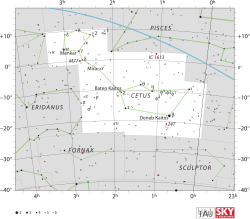Cetus
| Constellation | |

|
|
| Abbreviation | Cet |
|---|---|
| Genitive | Ceti |
| Pronunciation | /ˈsiːtəs/, genitive /ˈsiːtaɪ/ |
| Symbolism | the Whale, Shark, or Sea Monster |
| Right ascension | 00h 26m 22.2486s–03h 23m 47.1487s |
| Declination | 10.5143948°–−24.8725095° |
| Family | Perseus |
| Area | 1231 sq. deg. (4th) |
| Main stars | 15 |
|
Bayer/Flamsteed stars |
88 |
| Stars with planets | 23 |
| Stars brighter than 3.00m | 2 |
| Stars within 10.00 pc (32.62 ly) | 9 |
| Brightest star | β Cet (Deneb Kaitos)† (2.04m) |
| Nearest star |
Luyten 726-8 (8.73 ly, 2.68 pc) |
| Messier objects | 1 |
| Meteor showers |
October Cetids Eta Cetids Omicron Cetids |
| Bordering constellations |
Aries Pisces Aquarius Sculptor Fornax Eridanus Taurus |
|
Visible at latitudes between +70° and −90°. Best visible at 21:00 (9 p.m.) during the month of November. Note: †Mira (ο Cet) is magnitude 2.0 at its brightest. |
|
Cetus (/ˈsiːtəs/) is a constellation. Its name refers to Cetus, a sea monster in Greek mythology, although it is often called 'the whale' today. Cetus is located in the region of the sky that contains other water-related constellations such as Aquarius, Pisces, and Eridanus.
Although Cetus is not generally considered part of the zodiac, the ecliptic passes less than a quarter of a degree from its constellation boundary, and thus the moon, planets, and even part of the sun may be in Cetus for brief periods of time. This is all the more true of asteroids, since their orbits usually have a greater inclination to the ecliptic than the moon and planets. For example, the asteroid 4 Vesta was discovered in this constellation in 1807.
As seen from Mars, the ecliptic passes into Cetus, with the sun appearing in Cetus for around six days shortly after the northern summer solstice. Mars's orbit is tilted by 1.85° with
Mira ("the Wonderful"), designated Omicron Ceti, was the first variable star to be discovered and the prototype of its class. Over a period of 332 days it reaches a maximum apparent magnitude of 3 - visible to the naked eye - and dips to a minimum magnitude of 10, invisible to the unaided eye. Its seeming appearance and disappearance gave it its common name, which means "the amazing one". Mira pulsates with a minimum size of 400 solar diameters and a maximum size of 500 solar diameters. 420 light-years from Earth, it was discovered by David Fabricius in 1596.
...
Wikipedia
